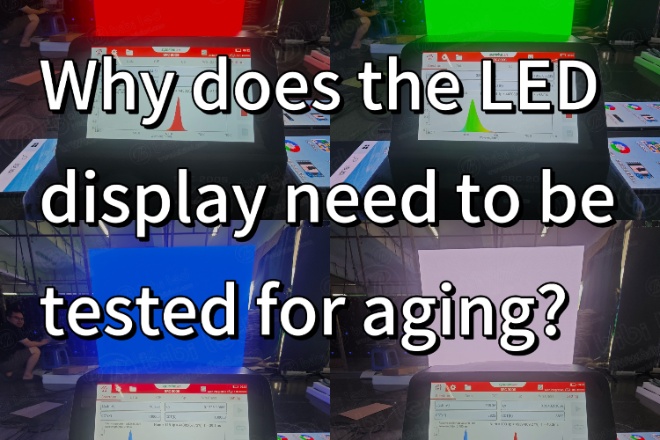Introduction

Do you know? There are actually a lot of tests to be done before the Affichage LED is shipped out of the factory, and the aging test is one of the most important ones. Then, someone may ask: What is an aging test? Why is an aging test needed?
This article will tell you about the most important test before the LED display is shipped out of the factory: the aging test.
1. What is the purpose of the aging test for LED displays?

When you walk on the bustling streets, LED display screens shine everywhere. But do you know? Behind these seemingly bright and beautiful screens, there is actually a crucial “physical examination” – an aging test.
It is like a comprehensive “interrogation” of the LED display screen, and the purpose is to make us feel more assured and comfortable when using it.
1). Performance “big test”:
Imagine the high temperature in the hot summer, the low temperature in the cold winter, and the humid rainy season. These extreme environments are not small challenges for LED displays. The aging test is to see whether the display screen can still work normally and whether the performance is stable under these “harsh” conditions.
It’s like giving the display screen an “extreme challenge” to see if it can withstand it. Moreover, by accelerating aging, we can also roughly predict the “lifespan” of the display so that manufacturers and users will have an idea in mind and know when to “change seasons.”
2). Stability test:
Long-term operation is a test for any device. LED display is no exception. The aging test is to see whether the LED display will “strike” or its performance will decline after a period of continuous operation.
This is like a “protracted-war” that tests the endurance and stability of the display. If any problems are found in the test, they must be “treated” quickly to ensure that the display can maintain its best condition when in use.
3). Pixel “magnifying glass”
The display effect of LED displays depends largely on the quality of pixels. The aging test is like a “magnifying glass” that can expose pixel problems that are not easy to detect at ordinary times, such as uneven luminosité, attenuation, inconsistent colors, etc.
In this way, we can “prescribe the right medicine” in time, repair or replace the problematic pixels, and ensure that the display effect of the display is always consistent.
4). Durability test
The durability of LED display is related to its “lifespan”. The purpose of the aging test is to see whether the display can remain “calm” when facing “external interference” such as environmental changes, temperature fluctuations, and unstable voltage.
It is like a “touchstone” that tests the “real skills” of the display. Only after such a test can we use the display more confidently without worrying that it will “fall off the chain” at a critical moment.
5). Color “palette”
Color consistency is a major “selling point” of LED displays. The aging test is like a “palette”. By comparing the display effects at different time points, we can find the problem of color deviation and make corrections and adjustments in time.
In this way, whether watching movies, watching games, or making advertisements, the color of the display can remain consistent, allowing us to enjoy a more realistic visual experience.
6). Fault “troubleshooter”
The aging test also has an important task, that is, “troubleshooter.” During the test, if the display fails or has problems, we can find and locate it in time. This is like a “detective game”.
We have to find the “culprit” of the failure and then “prescribe the right medicine” to ensure that the display can resume normal operation.
At the same time, this faulty information can also be fed back to manufacturers to help them improve their products and make future displays more reliable.
2. Methods of LED display aging test
Speaking of the LED display aging test, many people may think that this is a very difficult technical job. In fact, it is like a “comprehensive physical examination” of our home appliances, but this “physical examination” is more professional and strict. Today, let’s talk about the steps of the LED display aging test.
1). Test content:
The aging test is not simply to make the display light up, and that’s it. It has a whole set of “test” processes!
First, there is a “basic color parade”. White screen, red screen, green screen, blue screen, these basic colors are not missing, they have to be taken turns to see if the color of the display is accurate and stable when it is displayed in monochrome.
Next, it’s the “grayscale gradient challenge.” From black to white, gradually change over a little bit to see if the display can achieve a smooth transition. Don’t be like a “sawtooth” at that time; that would be embarrassing.
Of course, video and text effects cannot be left behind. Play a movie, broadcast a news, and then display some text to see if the display can remain smooth and clear when switching between dynamic and static content.
2). Test time:
After the test content is determined, the next step is to see the “endurance.” This aging test is not something that can be done in a short time, and it takes a lot of time!
The white screen test must start at least 24 hours to see if there will be any problems when the display is on for a long time.
The monochrome and grayscale gradient test also needs 24 hours to be primed so that the color performance of the display can be fully evaluated.
As for the video and text effect test, the time is even longer. The video aging test usually takes 48 hours, and the text effect test also takes more than 24 hours. This is a big challenge, and you have to see if the display can “hold up.”
This is also one of the reasons why your LED display has to wait several days before it can be packaged and shipped after it is completed, as this test link is really time-consuming.
3). Aging method:
After talking about the test content and time, let’s talk about the aging method. This aging test is not just about keeping the display on but also requires some “methods”:
- Constant current aging:
That is, to keep the current constant for aging testing. This method is in line with the current working characteristics of LEDs and can be said to be a scientific “torture” method. Through constant current aging, we can more accurately evaluate the performance stability and life of the display under long-term work.
- Constant voltage aging:
That is, to keep the voltage constant for aging testing. This method can test the performance of the display under voltage fluctuations to see if it can “cope with ease.”
- Overcurrent impact aging:
This is a “ruthless trick.” Through the aging test with a constant current source with adjustable frequency and current, the display is “surprised” to see if it can withstand a large current impact in a short time so as to quickly evaluate its quality life expectancy and pick out hidden dangers that may not be found in conventional aging tests.
3. What happens if the LED display does not undergo aging testing?

If the LED display does not undergo aging testing, it may bring a series of problems and risks. Let’s talk about this.
First of all, you have to know that the LED display is composed of a lot of LED lamp beads, and these lamp beads are not so “well-behaved” when they are working. Some of them may have performance degradation, dimming brightness, color deviation, and other problems due to unstable current and voltage or temperature rise caused by long-term work.
If you don’t do the aging test, these problems may not be seen when the display is just out of the factory, but once it reaches the customer and has been used for a period of time, the problems will slowly emerge.
In this way, the customer will definitely be dissatisfied. Where is the high-quality display? Why do so many problems appear after using it for a short time? This will not only affect the customer experience but also damage the reputation of the manufacturer.
At that time, a series of troubles such as return, exchange, repair, and compensation will come, and the manufacturer will have a headache.
Besides, if you don’t do the aging test, you may miss some potential hidden dangers. Some LED lamp beads may perform well at the beginning, but over time, due to problems in materials, processes, or design, they may suddenly “strike,” resulting in a partially black screen, flickering, and other problems on display.
These problems are difficult to detect without an aging test. By the time the problem actually occurs, it may have caused irreparable damage.
Moreover, not doing an aging test may also affect the life of the display. A display that has not undergone an aging test is like a person who has not been exercised. The body function may be relatively poor, and it is easy to “get sick.”
And the display that has undergone an aging test is like a person who has been exercised. The body is stronger and can better cope with various challenges and changes.
Therefore, in order to ensure the quality and reliability of LED display screens, manufacturers must conduct aging tests. This is not only a manifestation of responsibility to customers but also a maintenance of their own brand reputation.
Through aging tests, we can discover and deal with problems and hidden dangers in the display screen in a timely manner and ensure that customers can enjoy stable and high-quality display effects during use.
Conclusion
In summary, the aging test plays a vital role in the production and application of LED display screens.
It can not only effectively screen product defects and improve product stability and reliability but also provide solid support for the continuous innovation and healthy development of the industry.
Enfin, si vous souhaitez en savoir plus sur les écrans d'affichage LED, veuillez nous contacter.
